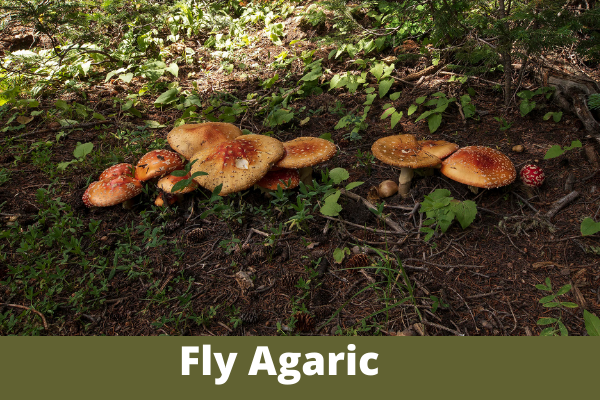Fly Agaric Mushrooms in the Cimarron River area are edible but do not make for a pleasant meal. They can taste like bitter almonds; other tasting compounds include strawberry, pepper, onion, and garlic. Yet flies thrive on the mushrooms and should consider as a part of their diet.
Fly agaric is reported to contain ibotenic acid, muscimol, homobol-A, and psathyra. Ibotenic acid can be converted into muscimol by the body, but it takes several hours to convert enough ibotenic acid to cause death. Other toxins in fly Agaric include alpha-amanitin, phalloidine, and verotoxin.
The Danger Of Fly Agaric
The toxicity of fly Agaric is probably best explained by the case of seven French painters who ate mushroom soup made from fly Agaric. They died after eating the soup.
Amanita muscaria has been used as a potent poison for thousands of years. Previously, it was mixed with opium and used as an anesthetic. In the 1600s, it was exported from Siberia to China as a pharmaceutical drug used as a treatment for malaria.
In the 17th century A.D., the Chinese the used fly agaric as a love potion. And in the early 1900s A.D., it uses as a recreational mood-enhancer.
Also read: Best Mods For Far Cry Primal
In rural Russian villages, flies traps different species of Amanita by placing them in a glass jar with a few flies inside. In this environment, fly agaric retained its red color and pungent odor, but the flies died quickly due to the toxic effects of ibotenic acid and muscimol.
Death Cap
The common name “death cap” comes from the fact that this genus of mushrooms is deadly poisonous. Although it is not a “true” mushroom, it does have a fruiting body capable of producing spores and thus appears to be alive.
In 1986, I found a single death cap growing beside the Cimarron River, near the Middle Fork Valley headwaters. In June 2001, along the same river, I found over 100 fly agarics growing in an area flooded by storms several days earlier.
Amanita phalloides
Amanita phalloides have been around for more than 1 million years. The poison of this species is the alkaloid alpha-amanitin. Digestion of this fungus by humans or animals can cause severe liver damage and death at any time after eating the mushrooms.
Must read:
- Giancarlo Esposito Appears In Far Cry 6 Trailer As A Threatening Villain
- Destroy All Humans Remake: Changes After Remake
Unfortunately, alpha-amanitin does not break down in digestion and has a half-life of four days in the human body.
Jeff Mitton Natural Selections Research
Jeff Mitton, a Colorado State University professor of ecology and evolutionary biology, studies organisms’ interactions and environments. His research has taken him from the endangered alpine ecosystems of Peruvian Andes to the Pamir Mountains of central Asia.
In between, he has scuba-dived in Indonesia, lived in Nepal on a National Science Foundation fellowship, taught university courses in Costa Rica and Indonesia, and managed a nature preserve in Colorado.
The deadly poisonous Amanita muscaria was once considered to be the “food of the gods.” It is edible, and some indigenous peoples in North America and South America still gather it. The fly agaric is a member of the genus Amanita and can cause death if eaten.
Fly agaric (Amanita muscaria) is a large, orange to red mushroom with white warts on its cap. The mushroom has a reputation of being psychoactive, laced with hallucinogens, and poisonous.
Is it true there are one thousand species of amanita mushrooms in the world? A recent study of amanita DNA revealed that the genus Amanita is more than just one large, single species. It composes about 500 different species.
Characteristics Of Fly Agaric
What are the characteristics of fly Agaric? Fly agaric is edible, inedible, poisonous, deadly toxic, and psychoactive. It integrates ibotenic acid and muscimol, which are both poisonous.
Signs of poisoning involve illness, vomiting, dizziness, illusions, automatic movements, fever, and convulsions.
What uses as an anesthetic in ancient Egypt? Amanita muscaria uses as a potent poison for thousands of years. In ancient Egypt, it mixes with opium and used as an anesthetic.
Digestion Of Fungus Can Cause Liver Damage
Amanita phalloides have been around for more than 1 million years. The poison of this species is the alkaloid alpha-amanitin.
Digestion of this fungus by humans or animals can cause severe liver damage and death at any time after eating the mushrooms. Unfortunately, alpha-amanitin does not break down in digestion and has a half-life of four days in the human body.
Also read:
- Best Minecraft Modpacks You Should Try Now
- Phanteks Declares Extreme Performance Glacier One 240T30 CPU Cooler! Detailed News!
How big is a fly agaric? The common name “death cap” comes from the fact that this genus of mushrooms is deadly poisonous.
Jeff Mitton, a Colorado State University professor of ecology and evolutionary biology, studies organisms’ interactions and environments. His research has taken him from the endangered alpine ecosystems of Peruvian Andes to the Pamir Mountains of central Asia.
Stay tuned with us for more news and updates!

